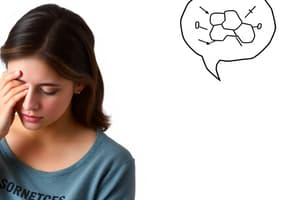Podcast
Questions and Answers
What is the primary goal of Stage 3 in the biopsychosocial model?
What is the primary goal of Stage 3 in the biopsychosocial model?
- To address family and social network factors contributing to symptoms
- To diagnose comorbid psychiatric problems
- To prescribe psychopharmacologic interventions
- To explain the link between physical, psychological, and social factors (correct)
What is the purpose of reframing complaints in a biopsychosocial model?
What is the purpose of reframing complaints in a biopsychosocial model?
- To develop a treatment plan
- To identify underlying medical conditions
- To link physical, psychological, and social factors (correct)
- To assign blame to family members or teachers
What is an example of a coping technique that can be taught to a child with headaches?
What is an example of a coping technique that can be taught to a child with headaches?
- Medication management
- Muscular relaxation (correct)
- Cognitive-behavioral therapy
- Surgery
What is the role of the clinician in addressing help-seeking behavior?
What is the role of the clinician in addressing help-seeking behavior?
What is an example of a life event that can exacerbate physical symptoms?
What is an example of a life event that can exacerbate physical symptoms?
What is the purpose of addressing family and social network factors?
What is the purpose of addressing family and social network factors?
What is the role of depression in physical symptoms?
What is the role of depression in physical symptoms?
What is an example of a practical explanation for how stress, tension, and anxiety cause physical symptoms?
What is an example of a practical explanation for how stress, tension, and anxiety cause physical symptoms?
What is the role of graded physical exercise in managing symptoms?
What is the role of graded physical exercise in managing symptoms?
What is the purpose of considering psychopharmacologic interventions?
What is the purpose of considering psychopharmacologic interventions?
Flashcards are hidden until you start studying
Study Notes
Somatization in Children
- Parents often report symptoms suggestive of somatization in children as young as 5-7 years old.
- Somatization-related disorders in young children are primarily manifested through parental concerns, beliefs, and behaviors.
Clinical Presentations and Diagnosis
- Typical presentations in children include:
- Recurrent episodes of severe abdominal pain, headaches, or vomiting
- Accompanied by lethargy, pale appearance, and unwellness
- May look like tension headaches, but sometimes coexist with migraine attacks
- Additional complaints of other less prominent physical symptoms, mood changes, and marked impairment with reduction in social contact and school absence are common.
Assessment and Diagnosis Tools
- Chalder Fatigue Scale (CFS): measures physical and mental fatigue in patients
- Functional Disability Inventory (FDI): assesses physical impairment and functioning
- Munich-Composite International Diagnostic Interview (M-CIDI): diagnoses somatoform and dissociative disorders
- Schedules for Clinical Assessment in Neuropsychiatry (SCAN): diagnoses somatoform and dissociative disorders
- The Child and Adolescent Psychiatric Assessment (CAPA): assesses symptom diagnosis based on information on onset date, duration, frequency, and impact
- The Preschool Age Psychiatric Assessment (PAPA): assesses symptom diagnosis in preschool children
- The Soma Assessment Interview (SAI): assesses functional somatic symptoms and impairment
Management and Treatment
- Necessary investigations to exclude organic disease and discuss with parents tactfully
- Modify harmful aspects in the child's environment (e.g., excessive academic and emotional demands)
- Share information about population frequency of FSS, risk factors, and management strategies to "normalize" the problem and "empower" families
- Specialized mental health treatment, including family CBT and pharmacological treatment, may be necessary
- Reframe complaints in a biopsychosocial model, linking physical, psychological, and social factors
- Help the child and family learn new coping techniques and address contributing factors in the family or school
Studying That Suits You
Use AI to generate personalized quizzes and flashcards to suit your learning preferences.




